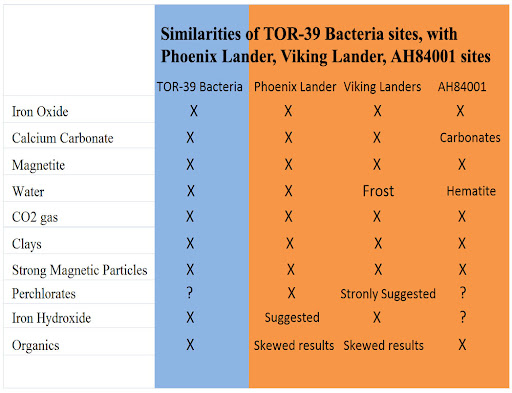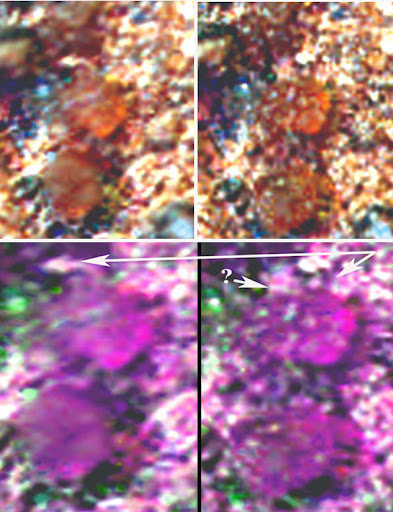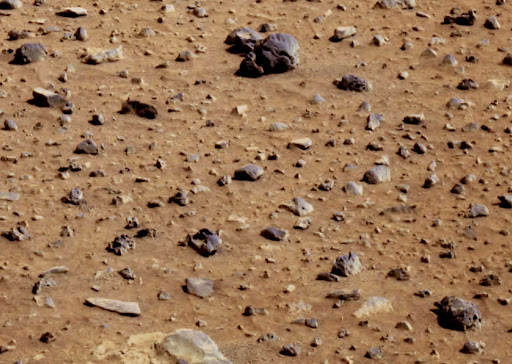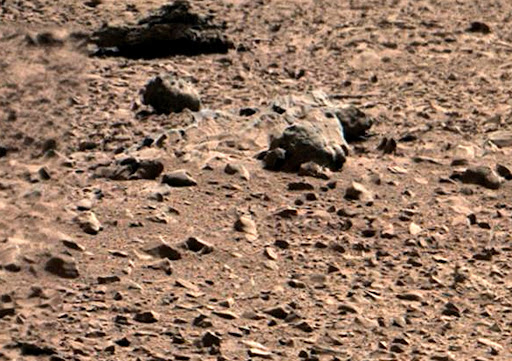New Mars Forums
You are not logged in.
- Topics: Active | Unanswered
Announcement
#1 2012-07-11 02:40:59
- mars-images
- Banned
- Registered: 2005-09-23
- Posts: 77
- Website
The Phoenix Lander found life on Mars
There is life on Mars and it was there when the Viking Lander dug it up and more recently when the Phoenix Lander dug it up. See this 6 minute video and pay close attention to the ending...
Here are the youtube location
Mars Life Found
Microscopic Life Found on Mars
Here is a chart about the similarities between Viking, I, II, Phoenix Lander, TOR-39 - a extremophile microbe living 2 miles down in a South African gold mine, and Allen Hill 84001 meteorite.

Here is one of the time lapse images taken of an extremophile like object with a scorpian-like tail moving around in the Phoenix Landers microscopic imager. Have fun:

Last edited by mars-images (2012-10-20 21:15:38)
Offline
Like button can go here
#2 2012-09-01 14:09:20
- GW Johnson
- Member
- From: McGregor, Texas USA
- Registered: 2011-12-04
- Posts: 6,108
- Website
Re: The Phoenix Lander found life on Mars
I looked at the film and the images. I think the moving round things in the film are rock dust particles moving in the wind. There were no "microscopic" imagers of any kind on any of these probes, only "magnifying imagers". You are looking at things on the order of 0.01 to 0.1 mm in size, not bacteria sizes (nanometers down to angstroms).
That being said, I do indeed favor the view that the Allan Hills meteorite contained bacterial fossils. I do indeed favor the view that the unusual chemistry on Mars today has skewed the search for compounds associated with life from Viking onward. I think the NASA scientists who detected those fossils in the Allan Hills meteorite were very badly treated.
What I expect to come out as the truth, probably long after I am dead, is that early Mars abounded with microbial life, but never had the time (around 3 billion years) for complex forms to evolve, before it acidified, dried out, froze, and lost its atmosphere. It is quite possible, indeed quite likely, that deep underground, there is still microbial life on Mars, resembling quite strongly the deep underground microbes found here in recent years.
I rather doubt there's anything alive on or near the surface, due to the ionizing radiation, and due to the extreme dessication that a near-vacuum of an atmosphere enforces. But I think if you look with a microscope, you will find fossils of what once was alive on the surface.
If we terraform Mars, that underground life could come blossoming back to the surface. Actually, I think it will be found to be quite similar to life here, although the base pair sequences in the DNA or RNA will be quite different. This would be true even if the panspermia hypothesis is true, because the isolation has been 4.5 billion years. I doubt it could infect or hurt us, or that our bacteria could hurt it.
But I am an engineer, not a biologist. I just read things in the journals. Why believe me?
GW
GW Johnson
McGregor, Texas
"There is nothing as expensive as a dead crew, especially one dead from a bad management decision"
Offline
Like button can go here
#3 2012-10-09 02:04:28
- mars-images
- Banned
- Registered: 2005-09-23
- Posts: 77
- Website
Re: The Phoenix Lander found life on Mars
Here on earth there are typically 40 million bacterial cells in a gram of soil and a million bacterial cells in a millilitre of fresh water; in all, there are approximately five nonillion (5×1030) bacteria on Earth, forming a biomass that exceeds that of all plants and animals.
Some bacteria do grow larger than 0.7 mm like the E. fishelsoni and the collodictyon which date back over 3.7 billion years ago is the size of one of those moving life-like objects. There are several reasons I think this could be life. Water ice was first verified at the Phoenix Lander, subsurface life would be under pressure therefore trapped water vapor and gas can make the pressure much higher just below the surface where water would form during a certain time of day and season. Extemophiles like Tardigrades can survive the vacuum of space, thousands of times more radiation than humans can in a suspended animation type cocoon called a tune and live years without water. These life like objects would be like fish out of water when first dug up.
With that being said look what I found at Curiosity sol 62 looks like a worm that was just dug up by the shovel they used to dig up some sand???

Last edited by mars-images (2012-10-09 02:06:41)
Offline
Like button can go here
#4 2012-10-12 22:15:22
- mars-images
- Banned
- Registered: 2005-09-23
- Posts: 77
- Website
Re: The Phoenix Lander found life on Mars
New close-up image of bright spot, looks like someone on Mars tried to roll a joint???

Offline
Like button can go here
#5 2012-10-14 00:34:36
- mars-images
- Banned
- Registered: 2005-09-23
- Posts: 77
- Website
Re: The Phoenix Lander found life on Mars
One thought that occurred to me is that what better way to test some of the equipment out, than to do it on an object we built ourselves, by knowing what the composition of that object is we can calibrate our equipment. One way would be to use the laser to heat-up the bright object that supposedly fell from the sky from the descent of the MLS and see how it reacts to the Martian environment and what spectrum comes out of it. On earth we can do the same thing with like equipment.
Offline
Like button can go here
#6 2012-11-20 16:38:21
- mars-images
- Banned
- Registered: 2005-09-23
- Posts: 77
- Website
Re: The Phoenix Lander found life on Mars
Curiosity team to announce new " "for the history books" announcement to be made within two weeks.
http://www.space.com/18565-mars-rover-c … stery.html
My guess is that they will finally confirm organics in the soil the next step is confirming extant (still in existence) life on Mars that they also found at the Viking and Phoenix Landers site. Viking Landers found organics, the Phoenix Lander discovered it but couldn't verify it because of perchorates in the soil skewed the results, it will be confirmed that what Chris McKay said in 2010.
"In 2010 The discovery of the highly reactive chemical perchlorate in the phoenix Lander led NASA's Christopher McKay, an astrobiologist at the Ames Research Center, and Navarro-Gonzalez to test whether the perchlorate had skewed the Viking results that showed no sign of organic material on Mars.
Perchlorate, which consists of chlorine and oxygen, actively absorbs electrons from surrounding compounds when heated. "It could sit there in the Martian soil with organics around it for billions of years and not break them down," McKay said. "But when you heat the soil to check for organics, the perchlorate destroys them rapidly."
Last edited by mars-images (2012-11-20 16:43:53)
Offline
Like button can go here
#7 2012-11-28 01:03:41
- mars-images
- Banned
- Registered: 2005-09-23
- Posts: 77
- Website
Re: The Phoenix Lander found life on Mars
Imagine a world similar to earth early in its history where life was abundant on land, in the sea and underground, a world where an apocalyptical event much greater than the one that killed the dinosaurs off was about to hit the planet. Imagine the terror of Martian life forms looking up into the night sky when it happened. The planet shook from a large comet exploding after impact filling the night sky with 3 thousand degrees hot plasma, 8 million cubic miles of impacted debris and poisonous gas. A force over 1 million times greater than the power of the nuclear bomb that was dropped on Hiroshima Japan just shook the planet impacting at the Hellas Impact basin area as a result the crater floor is now about 7,152 m (23,465 ft) deep extending about 2,300 km (1,400 mi) east to west.
Are we seeing its victims here?
https://picasaweb.google.com/1041440224 … kingRocks#

The above thought was followed with half joking images I showed people at space.com blog in 2004 about what looked like a grave yard of fossils at the Spirit rovers landing site, I even named the rocks. After looking at over 10,000 images from the MER rovers nothing looked like the fossilize looking rocks at the Spirit rovers landing site. Looking at the images too much I started thinking that maybe that they were fossils, this was before they verified water on Mars with other data that supports the possibility of life on Mars at sometime in its history.
Now at Curiosity Landing site lets revisit that thought, are these fossilized rocks?
Dead Horse looking rock?

???


Last edited by mars-images (2012-11-30 14:34:16)
Offline
Like button can go here
#8 2012-11-28 16:42:12
- falkor
- Member
- From: Surrey
- Registered: 2004-08-21
- Posts: 112
Re: The Phoenix Lander found life on Mars
There is life on Mars and it was there when the Viking Lander dug it up and more recently when the Phoenix Lander dug it up
say this is confirmed
can you explain what the consequences would be? I'm not sure how this assists whether there was life on Mars or not, please clarify ![]()
Offline
Like button can go here
#9 2012-11-28 19:05:52
- mars-images
- Banned
- Registered: 2005-09-23
- Posts: 77
- Website
Re: The Phoenix Lander found life on Mars
The consequences if they do confirm large fossils on Mars would be unimaginably huge, even confirming microscopic life on Mars would alter humans conception of the universe. As far as habitable zones for life our outer solar system worlds that get hundreds of times less light than earth does has the best chance outside Mars of finding life, habitable zone that far out in our own solar system would mean almost all the stars no matter how cold they are may have life.
The only life forms we know of are carbon based as a result have organic chemicals. Our understanding of whether there is currently life on Mars or that there was life on Mars in the past is due to what we can extrapolate out of all the data we currently know about life on earth and information we get from exploring Mars. We currently know that there is water in the soil, the reason I said soil instead of regolith, regolith = similar to soil but without the organics, because I am sure there are organics on Mars although none to this date have been found -- see first post above that adds proof to this and the fact that Earth got all its water and organics from space, asteroids and comets, then why shouldn't Mars have some too since we know that it now has water ice. Water-ice and organics is abundant in our outer solar system away from the high UV's. Organics directly on Mars surface in high UV's would be destroyed so we have to dig it up to find it.
"In 2010 The discovery of the highly reactive chemical perchlorate in the phoenix Lander led NASA's Christopher McKay, an astrobiologist at the Ames Research Center, and Navarro-Gonzalez to test whether the perchlorate had skewed the Viking results that showed no sign of organic material on Mars.
Perchlorate, which consists of chlorine and oxygen, actively absorbs electrons from surrounding compounds when heated. "It could sit there in the Martian soil with organics around it for billions of years and not break them down," McKay said. "But when you heat the soil to check for organics, the perchlorate destroys them rapidly."
The Viking Lander dug some up but because it also dug up perchlorates that have a high amount of oxygen in it then as soon as they heated it up to check for organics it destroyed the organic before we could find it, the Phoenix Lander did the same thing. So to-date no organic has been found on Mars, without finding organics they will never admit to ever seeing something that looks like life on Mars, the phoenix Lander science team found a lot of perchlorates in the soil so they also couldn’t confirm organics because they didn’t anticipate this. NASA now knows what to do and not to do with curiosity and what to test for to confirm organics. So that big announcement that they will soon make, “"one for the history books.” may not only confirm organics they may also confirm advanced organic chemistry that is the precursor of life.
With that being said don’t hold your breath on a soon to be released "one for the history books announcement; it may not come this early in curiosities mission.
NBC report on "one for the history books"
http://video.msnbc.msn.com/nightly-news … /#50002282
Last edited by mars-images (2012-11-29 02:57:38)
Offline
Like button can go here